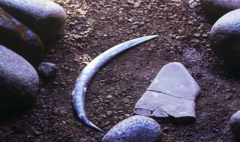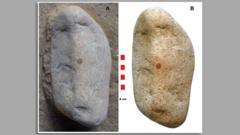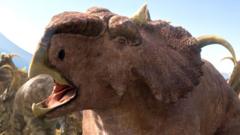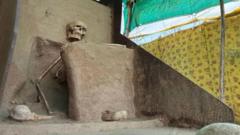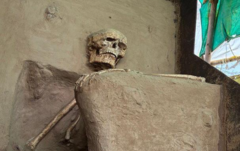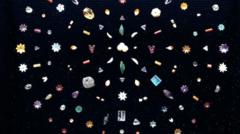A monumental excavation in Pompeii has revealed a lavish private bathhouse, potentially the largest of its kind in the ruins, highlighting the stark contrast of life and death during the eruption of Mount Vesuvius. The discoveries provide rich insights into Roman daily life, emphasizing the exquisite design of bathing facilities alongside the tragic fates of its last inhabitants.
Rediscovering the Luxurious Past: A Stunning Bathhouse Unearthed in Pompeii
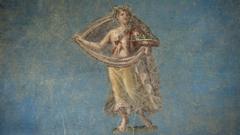
Rediscovering the Luxurious Past: A Stunning Bathhouse Unearthed in Pompeii
Archaeologists unveil a remarkable private bathhouse in Pompeii, shedding light on the opulent lifestyle of the ancient Romans.
After lying hidden beneath layers of volcanic ash for two millennia, an extraordinary bathhouse has been uncovered in the ancient Roman city of Pompeii, marking a "once-in-a-century" archaeological discovery. Described as potentially the largest private bathing complex found at the site, this opulent structure features hot, warm, and cold rooms, along with striking artwork and a massive plunge pool.
Dr. Gabriel Zuchtriegel, director of the Archaeological Park of Pompeii, revealed the find, noting how spaces like these contribute to the "Pompeii effect," evoking the feeling that the lives of these ancient people abruptly halted just moments before. Vibrant changing rooms adorned with red walls and geometrically patterned mosaic floors offer a glimpse into the luxurious rituals of bathing during the Roman Empire.
Unfortunately, the discovery also includes a poignant reminder of the catastrophic eruption of Mount Vesuvius in AD 79 that claimed many lives. Two skeletons were found in a small, locked room, revealing the desperate last moments of a woman between the ages of 35 and 50, clutching jewelry and coins, and a young man in his late teens who had taken refuge with her. The horrific force of the pyroclastic flow sealed their fates, providing dramatic insights into the persistence of human emotion amid disaster.
The excavation, the most extensive in a generation, has also unearthed other parts of a grand residence linked to a wealthy individual, perhaps Aulus Rustius Verus, a prominent politician of Pompeii. The immense wealth suggested by the bathhouse further underscores the lavish lifestyle reserved for the elite, with only a few residences constructing such intricate bathing facilities.
Richly decorated marble, gold jewelry, and legendary artistry reside within the new discoveries, including a large dining area and a shrine. In contrast, the remains of the two individuals reflect the hierarchical and often brutal lives of the Roman social structure, showcasing the stark difference in experience between the wealthiest citizens and those of lower status, possibly slaves.
Archaeologist Dr. Sophie Hay highlights the complexity of this divide, noting how elements such as the boiler room near the bathhouse emphasize the hard labor that sustained the luxurious lives of the elite. As the excavation nears completion, the team continues to uncover new findings daily, ensuring that Pompeii offers a narrative of resilience, opulence, and tragedy.
The public will soon be able to explore these incredible discoveries, which will enhance our understanding of daily life in ancient Rome. The excavation process is documented in a new BBC series, "Pompeii: The New Dig," showcasing the continuity of archaeological endeavor, where every day can yield surprises from the ashes of history.








